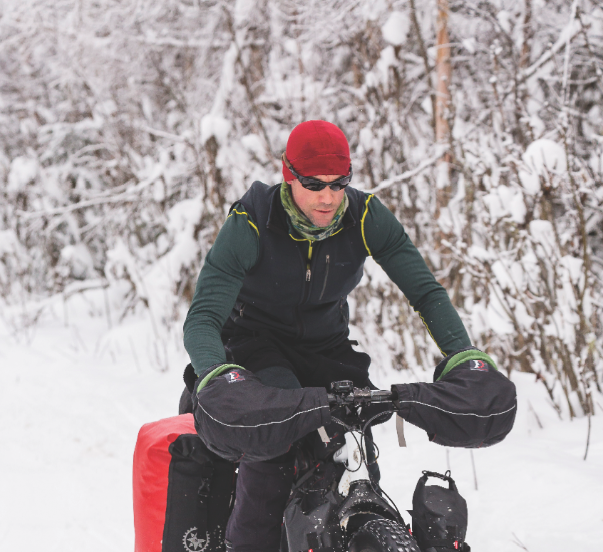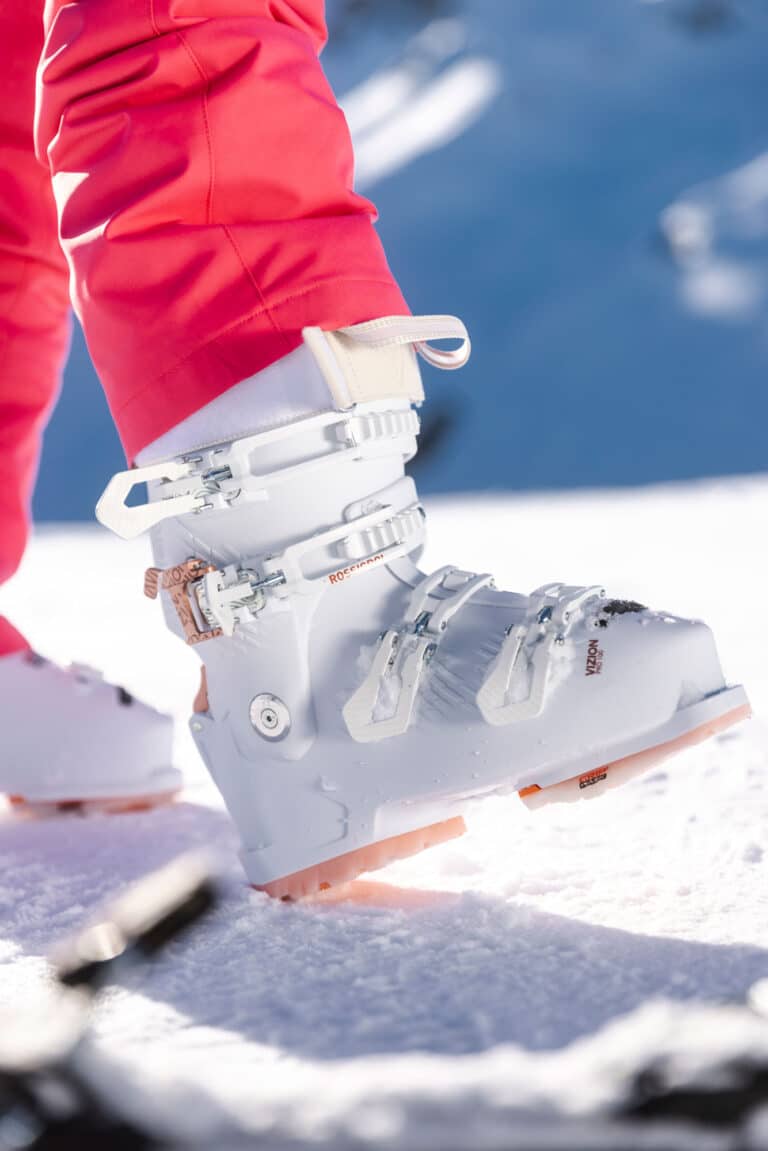Five-time Iditarod Trail Invitational finisher and Davis, W.Va., resident John Logar is heading back to Alaska to compete in the 1,000-mile race to Nome by bike. Back in 2014, Logar won the 1,000-mile Iditarod footrace, finishing in 23 days, 23 hours, and 10 minutes. He’s since ridden the 350-mile Iditarod route three years in a row, with times ranging from two days to five days. BRO sat down with Logar to talk about all things Iditarod, from training on fat bikes in West Virginia to sleepless nights in the Interior.
Your finishing times in 2015 and 2016 were wildly faster than last year’s. What was different about your 2017 ride?
JL: 2015 was fast and too quick. We had ice pack conditions so it was like riding on a sidewalk. We rode over 170 miles a day. I placed fourth that year and I think we all broke course records. 2016 was about the same, fast and warm. But 2017 was truly the first real winter race they’d had in three years. There was a 50% DNF rate.
When you say cold, how cold are we talking?
JL: It was 30 and 40 below freezing, with the wind chill, definitely colder, like 50 below. It was cold enough that it was hard to pedal. People had frostbite. It was bad. There was a ground blizzard one night entering Hell’s Gate and I waited a little longer to set out, but Jay Petervary and the leaders went ahead. The next day I saw this huge hole in the snow where they must have hunkered down and you just know they got their asses kicked.
What were the course conditions like?
JL: We had lots of snow. Sometimes it’s hard-packed; sometimes it isn’t. The route is pretty obvious for the most part, but new snow can make it disappear until the next snowmobile goes through it. I had a moose come through and post-hole and tear up the trail for about 10 miles, which sucked. Then there’s overflow, which happens when the river level rises above the ice. It can create a 10-foot wide slush field or there can be miles of it. You never know and you don’t always know where it’s coming from, but when you’re in it, you know you’re in it. Usually you’re going along and ‘clunk,’ you drop six inches through the ice. It’s the dreaded nightmare and one of the more stressful things up there because it’s the one element most of us don’t deal with normally.
What was the most challenging moment of the 2017 race?
JL: It wasn’t the cold. It wasn’t the wind. It was coming into the village of Nikolai. The checkpoint is this family’s home, the Petruska family. Nick Petruska is one of the village elders, and I’ve known him now for five years. He was like a father figure for Bill Merchant who started this race. Nick was sick with cancer, but he didn’t want to change the checkpoint. He kept his house open. His daughter woke me up in the middle of the night and said, “John, get up, Nick’s sick.” They know I’m a doctor, but we were in the middle of nowhere, and at that point you’re 400 miles from any sort of hospital care. He was confused, he had a fever. There just so happened to be a travel nurse in the village. I was able to get an IV and antibiotics in him, which resuscitated him. They flew him to Anchorage and I went and visited him after the race, but he died soon after.
How did the race change for you after you left the Petruska household?
JL: It was the worst part of the trip for me, because here I am riding my bike through the freaking winter, and this dude is dying. It just came back to the feeling that this is a selfish ass sport. I wasn’t doing anybody any good except for myself and meanwhile, here’s this selfless guy saying, “Come into my house, but I’m dying.” It was a different type of race for me after that. I hammered the race for years, but this time I just chilled out.
This will be your sixth year at the Iditarod Trail Invitational. What keeps you coming back?
JL: I’m drawn to people who have stepped outside their comfort zone. They get it.
What is your strategy going into this 1,000-mile bike race?
JL: The physical part is a big deal, it really is, but it’s not the biggest deal. It’s a mind game. I do not have a training regimen. I do not have a weekly mileage. It’s a lifestyle sport. I try to do something everyday, whether that’s a three-mile run or a five-hour ride. At the end of the day, every time I go [to the Iditarod], I’m ready to push my bike 350 miles. You should not approach this race like you’re going to ride it. You should be willing to get off your bike and push the whole thing if you have to. That being said, I sure as shit do not practice pushing my bike.
Let’s talk gear—what system did you have last year and are you making any changes?
JL: Last year I was on a Salsa Mukluk Ti, which I’ll be riding again. I had huge paniers on the sides. I wear a thin, old school Patagonia zip tee, my CamelBak, then a Patagonia R1 layer on top of that, then a vest, puffy, shell, and all of that is usually too hot. I usually lose the puffy. I wear a BUFF religiously around my neck. That’s a big heat sink for me. I also carry a light Ibex hat and a Mountain Hardware Windstopper heavy-duty hat, you know, that elf-looking thing, and goggles. You have to have goggles cause your eyes will get all messed up. On my legs, I wear three-quarter length wool riding tights, Mountain Hardware fleece windproof pants with full-length zips (it’s all about the ventilation), 45NRTH Wölvhammer studded boots with an expedition neoprene boot cover that comes up mid-shin, sock liners, and vapor barriers.
Only sock liners? In 30 below? That seems pretty minimal.
JL: It’s such a pain figuring out the feet. I just try to manage the moisture as best I can. Everybody tries to go GORE-TEX and I’d rather have as much moisture get away from my body as possible. I always have hand warmers and jam one into each toe box and it’s a dream come true.
What is one piece of gear that you’ll never do the Iditarod without?
JL: I started carrying a thermos for hot stuff. That was a game changer for me. At each checkpoint, if there’s hot water, I’ll put boiling water in it with two packs of ramen. That way if I’m 10 hours out and I’m like, “I want a warm meal,” bam. I have it.
What are you eating while you’re out on the course?
JL: I don’t cook meals out there. Zero. I’ll get real food in the villages and hold out for a couple of days if I have to. Snickers are my get-out-of-jail-free-card. I’ll stick those in my mouth like a cigar and just eat it as it melts. Paydays. Jerky. Last year I made eight bologna and American cheese on white bread sandwiches. I loved it. It’d be frozen, but you put a little mustard, a little mayo on there, put in your shirt for awhile and it’ll warm up. Reese’s Cups don’t freeze, so that’s a big deal. I had a lot of those individually wrapped packages of fruit and nut mixes that are 300-400 calories a pop. Variety is key.
In your experience, which is more challenging, the footrace or the bike race?
JL: The footrace is way harder. I’ve done both so I feel like I can say that.
How does living in Davis, W.Va., help prepare you for the Iditarod, or does it?
JL: The past two days I’ve ridden here it’s been 35 degrees and dumping rain. That’s about as uncomfortable as it gets. It sucks. You can’t stop, or you can, but it gets uncomfortable really quick. You’re not dry, so you have all kinds of weird chafing going on, you can’t see anything because it’s socked in. It works well for me because we have some seriously crappy weather so I can get out and continue to train myself to be comfortable with being uncomfortable. I also have a good wife and family and a supportive bike shop, so that helps.








